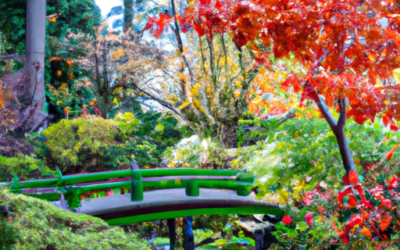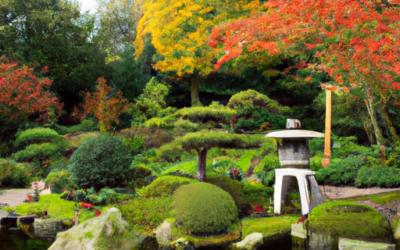“Visiting Japanese Gardens: Essential Travel Tips and Destinations in the West” is your go-to guide for immersing yourself in the serene beauty of these cultural gems. Whether you’re a passionate green thumb or simply enjoy experiencing different cultures, this eye-opening guide offers a unique look at some of the most picturesque Japanese gardens in the West that you can visit. This guide not only pinpoints must-visit destinations, from the renowned Storrier Stearns Japanese Garden in Pasadena to the tranquil havens in Oregon and Washington, but also provides useful travel tips and insights into the fascinating history and aesthetic principles behind these serene landscapes. Filled to the brim with interesting trivia and essential information, this handy guide promises to help you create an unforgettable journey into the heart of Japan’s art and culture without setting foot outside the West.
Understanding the Importance of Japanese Gardens
Japanese gardens hold significant cultural value in Japan. With a balance of aesthetic pleasure and purposeful design, these gardens embody the principles of serenity and tranquil reflection often tied to zen Buddhism.
Significance of Japanese Gardens in Japan’s Culture
These peaceful havens serve as a testament to the refined sensibilities of the Japanese people, mirroring their deep-rooted respect for nature and keen eye for aesthetic beauty. Throughout history, Japanese gardens have been places for contemplation and spiritual awakening, playing an essential role in practices such as tea ceremonies.
Different Styles of Japanese Gardens
There are various styles, each with distinct features that tell a unique story about its creation. From Karesansui (dry landscape gardens) echoing the minimalist concept of Zen Buddhism, to Tsukiyama (hill gardens) that depict miniature versions of natural landscapes – each style provides a different perspective on Japanese culture and values.
Main Goal of Japanese Gardens: Peace
The ultimate goal behind these artistic displays is to establish a sense of peace and tranquility. A Japanese garden serves as an invitation to escape from the hustle-bustle of daily life, to come and find serenity among the exquisite landscape designs.
Introduction to Japanese Gardens in the West
Western world’s fascination with Japanese gardens began during the early 19th century, and their influence remains prevalent today.
History of Japanese Gardens in the West
The influx of Japanese immigrants and an increase in travel during the early 1900s ignited the West’s interest in Japanese gardens. This led to the propagation of Japanese-style landscapes in many Western nations which continue to be enjoyed today.
Influence of Japonism on Western Landscapes
Japonism, a trend that stemmed from the West’s admiration for Japanese art and design, significantly shaped the garden landscapes of Europe and America. It brought a touch of Japan’s serene beauty to Western gardens, infusing them with tranquility and simplicity, two core elements of Japanese design.
Impact of Japanese Immigrants on Western Japanese Gardens
Japanese immigrants played a pivotal role in introducing Japanese garden elements to the Western world. Their knowledge and exquisite craftsmanship facilitated the creation of authentic Japanese gardens in an entirely new environment, thereby spreading the tranquil beauty of their homeland across the globe.
Tips for Visiting Japanese Gardens
Visiting a Japanese garden can be a soul-enriching experience. Here are some tips to make the most of your visit.
Best Time to Visit Japanese Gardens
Early morning or later in the evening is an ideal time to visit as the gardens are often less crowded, allowing for a peaceful, uninterrupted experience. If you’re after a visual treat, spring and autumn are spectacular due to the cherry blossoms and vibrant fall colours.
Packing Essentials for Garden Visits
Comfortable attire and footwear are a must. Equipping yourself with a bottle of water, sunscreen, and a hat could also help, especially during the hotter months. Don’t forget your camera to capture the breathtaking sights!
Guidelines and Rules to Follow in Japanese Gardens
Respect the serenity of the space by maintaining silence, not littering, and adhering to the allocated paths. It’s essential to remember that these gardens are a place for quiet reflection and must be treated with utmost respect.
Spotlights on Renowned Gardens: Designer Kinzuchi Fujii’s Creations
Kinzuchi Fujii, an accomplished Japanese landscape artist, left a lasting impact on Western Japanese Gardens, particularly in Southern California.
Overview of Kinzuchi Fujii’s Legacy
Fujii created several outstanding Japanese landscapes across Southern California in the early 20th century, leaving a rich legacy of peaceful sanctuaries echoing the tranquillity of his homeland.
Insights into Storrier Stearns Japanese Garden in Pasadena
Perhaps Fujii’s most notable work, the Storrier Stearns Japanese Garden in Pasadena, is a beautiful example of a hill-and-pond-style garden. Despite the passing of time, this garden remains as Fujii’s only intact creation and serves as a tranquil oasis in the heart of Pasadena.
Why Storrier Stearns is Fuji’s Only Remaining Garden
During the anti-Japanese hysteria of World War II, many of Fujii’s creations were destroyed. However, Storrier Stearns survived, thus preserving an inspiring testament to Fujii’s excellent craftsmanship and signature style.
Experiencing the Huntington Japanese Garden in Los Angeles
The Huntington Japanese Garden in Los Angeles replicates the tranquil beauty of a traditional Japan
Distinct Features of the Huntington Japanese Garden
Known for its moon bridge, this garden is a visual treasure trove. It also features a Japanese house, ceremonial tea house, bonsai collection, and zen court, giving visitors a comprehensive Japanese experience.
What to Look out for at the Huntington Japanese Garden
While you are there, make sure to check out the beautifully manicured Bonsai collection and spend some time at the Zen court. The quiet serenity of the place is sure to make your visit worthwhile.
Highlighting Huntington’s Bonsai Collection and Zen Court
The Bonsai Collection and Zen Court are standout features of the Huntington Garden. The miniature trees are meticulously cared for, and the Zen court is designed for contemplation and meditation, a place where you can find inner peace.
Unveiling Ganna Walska Lotusland: Santa Barbara’s Green Gem
Ganna Walska Lotusland in Santa Barbara is a beautiful marriage of Japanese and Californian horticultural elements.
History of Ganna Walska Lotusland
Originally the estate of the late Madame Ganna Walska, a Polish opera singer, Lotusland is now a beautiful garden open to the public. Her fascination with a variety of horticultural styles resulted in a multi-faceted garden including a stunning Japanese section.
Exploring the Japanese Horticulture in Lotusland
Lotusland showcases Walska’s take on Japanese horticulture, evident from the serene reflection pond and Miwatasu. These elements inject a distinctly Japanese charm into the Californian landscape.
Miwatasu: The Scenic Overlook in Lotusland
Don’t forget to experience the Miwatasu, a vantage point offering a birds-eye view of the Japanese gardens. It provides the perfect spot for a peaceful moment of reflection.
Hayward Japanese Garden: A Small yet Vibrant Oasis
The Hayward Japanese Garden may be small, but it is a perfect manifestation of the saying, “The best things come in small packages.”
Discovering the Fauna and Flora of Hayward
Hayward’s Japanese Garden is home to an extensive variety of Japanese flora, fauna, and trees, despite its smaller size. This peaceful haven provides the perfect spot to relish in some fresh air and tranquillity.
Experiencing Tranquility in Hayward’s Japanese Garden
Even though it is smaller in scale, Hayward’s Japanese Garden doesn’t compromise on the tranquillity factor. A visit here offers an escape from the busyness of daily life and a step into a world of peace and beauty.
Steeping into History: Storrier Stearns Japanese Garden in Pasadena
Another of Kinzuchi Fujii’s masterpieces, Storrier Stearns Japanese Garden, offers a unique experience steeped in history and tradition, best evidenced by its tea ceremonies.
Tea Ceremonies at Storrier Stearns
Experiencing a traditional Japanese tea ceremony at the Storrier Stearns Japanese Garden is a must-do. This ritual steeped in history offers an opportunity to appreciate the flavours and intricacies of Japanese tea culture.
Appointments and Visiting Hours at Storrier Stearns
Managed with great care, the Storrier Stearns Japanese Garden is opened for visits by appointment. So, ensure to check the operation hours and schedule your visit ahead of time as it is a private garden offering a more exclusive experience.
Basking in Seattle’s Traditional Stroll Garden: Seattle Japanese Garden
The Seattle Japanese Garden is a stunning representation of a traditional stroll garden.
Understanding the Principle of Shizensa
Shizensa, or the ‘essence of nature’, is the guiding principle behind the design of the Seattle Japanese Garden. The aim was to create an environment that not only resembles but also feels like natural landscapes.
A Walk through Japan’s Various Environments at Seattle Japanese Garden
As you stroll through the gardens, it’s as if you’re journeying across Japan’s diverse natural environments. Mountaintop views, forest trails, rivers, lakes, waterfalls, islands, and seas are depicted using plants, rocks, and water.
Discovering the Pacific Northwest Twist in this Japanese Garden
A delightful fusion of Japanese and Pacific Northwest aesthetics is evident in the garden. Juki Iida, the garden’s designer, incorporated local materials into the design adding a touch of Seattle to this Japanese gem.
Sasebo Japanese Garden: Where New Mexico Meets Japan
The Sasebo Japanese Garden in Albuquerque ingeniously incorporates the local culture and geography of New Mexico into the timeless artistry of Japanese gardens.
Sasebo: A Synthesis of New Mexico and Japan
The Sasebo Japanese Garden stands out due to its fusion of traditional Japanese garden design with New Mexico’s native flora. It paints a beautiful picture of how two distinct cultures can harmoniously merge.
Appreciating the Pruned and Sculpted Trees at Sasebo
At Sasebo, local trees are expertly pruned and sculpted, in line with Japanese garden aesthetics. This profitable blend of local fauna and Japanese design makes it a unique garden to visit.








